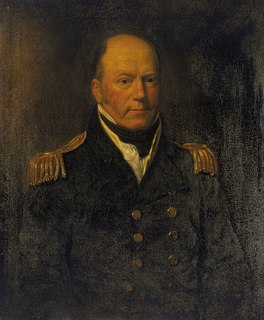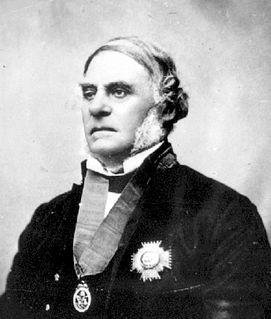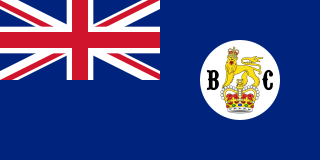
British Columbia is the westernmost province of Canada, situated between the Pacific Ocean and the Rocky Mountains. It has a diverse geography, with rugged landscapes that include rocky coastlines, sandy beaches, forests, lakes, mountains, inland deserts and grassy plains, and borders the province of Alberta to the east and the Yukon and Northwest Territories to the north. With an estimated population of 5.3 million as of 2022, it is Canada's third-most populous province. The capital of British Columbia is Victoria and its largest city is Vancouver. Vancouver is the third-largest metropolitan area in Canada; the 2021 census recorded 2.6 million people in Metro Vancouver.

Captain George Vancouver was a British Royal Navy officer best known for his 1791–1795 expedition, which explored and charted North America's northwestern Pacific Coast regions, including the coasts of what are now the Canadian province of British Columbia as well as the US states of Alaska, Washington and Oregon. He also explored the Hawaiian Islands and the southwest coast of Australia.

New Westminster is a city in the Lower Mainland region of British Columbia, Canada, and a member municipality of the Metro Vancouver Regional District. It was founded by Major-General Richard Moody as the capital of the Colony of British Columbia in 1858 and continued in that role until the Mainland and Island colonies were merged in 1866. It was the British Columbia Mainland's largest city from that year until it was passed in population by Vancouver during the first decade of the 20th century.

The history of British Columbia covers the period from the arrival of Paleo-Indians thousands of years ago to the present day. Prior to European colonization, the lands encompassing present-day British Columbia were inhabited for millennia by a number of First Nations.

The City of North Vancouver is a city on the north shore of Burrard Inlet, British Columbia, Canada. It is the smallest in area and the most urbanized of the North Shore municipalities. Although it has significant industry of its own – including shipping, chemical production, and film production – the city is considered to be a suburb of Vancouver. The city is served by the Royal Canadian Mounted Police, British Columbia Ambulance Service, and the North Vancouver City Fire Department.

The District of North Vancouver is a district municipality in British Columbia, Canada, and is part of Metro Vancouver. It surrounds the City of North Vancouver on three sides. As of 2016, the District stands as the second wealthiest city in Canada, with neighbouring West Vancouver the richest. The municipality is largely characterized as being a relatively quiet, affluent suburban hub home to many middle and upper-middle-class families. Homes in the District generally range from mid-sized family bungalows to very large luxury houses. A number of dense multi-family and mixed-use developments have popped up across the district in recent years; however, the District remains a primarily suburban municipality. The District is served by the Royal Canadian Mounted Police, British Columbia Ambulance Service, and the District of North Vancouver Fire Department.

William Robert Broughton was a British naval officer in the late 18th century. As a lieutenant in the Royal Navy, he commanded HMS Chatham as part of the Vancouver Expedition, a voyage of exploration through the Pacific Ocean led by Captain George Vancouver in the early 1790s.

Sir James Douglas was a British Columbian fur trader and politician who became the first Governor of the Colony of British Columbia. He is often credited as "The Father of British Columbia." He was instrumental to the resettlement of 35 African-Americans fleeing a life of racial persecution in San Francisco who arrived in the province aboard the steampship Commodore in what later became known as the Pioneer Committee. In 1863, Douglas was knighted by Queen Victoria for his services to the Crown.

HMS Discovery was a Royal Navy ship launched in 1789 and best known as the lead ship in George Vancouver's exploration of the west coast of North America in his famous 1791-1795 expedition. She was converted to a bomb vessel in 1798 and participated in the Battle of Copenhagen. Thereafter she served as a hospital ship and later as a convict ship until 1831. She was broken up in 1834.

The Fraser Canyon Gold Rush, began in 1858 after gold was discovered on the Thompson River in British Columbia at its confluence with the Nicoamen River a few miles upstream from the Thompson's confluence with the Fraser River at present-day Lytton. The rush overtook the region around the discovery, and was centered on the Fraser Canyon from around Hope and Yale to Pavilion and Fountain, just north of Lillooet.

Lynn Canyon Park is a municipal park in the District of North Vancouver, British Columbia. When the park officially opened in 1912 it was only 12 acres (4.9 ha) in size, but it now encompasses 617 acres (250 ha). The park has many hiking trails of varying length and difficulty. The Baden-Powell Trail passes through the park crossing over the Lynn Canyon Suspension Bridge. Due to its natural landscape many TV series such as Stargate SG-1 and Stargate Atlantis used the area for filming.
Nelson Mathew Skalbania is an engineer and businessman from Vancouver, British Columbia who is best known for signing a then 17-year-old Wayne Gretzky to the Indianapolis Racers of the World Hockey Association, and for his high-profile real estate flipping.

The Colony of British Columbia was a British Crown Colony that resulted from the amalgamation of the two former colonies, the Colony of Vancouver Island and the mainland Colony of British Columbia. The two former colonies were united in 1866, and the united colony existed until its incorporation into the Canadian Confederation in 1871.

The Colony of British Columbia was a crown colony in British North America from 1858 until 1866 that was founded by Richard Clement Moody, who was selected to 'found a second England on the shores of the Pacific', who was Chief Commissioner of Lands and Works for British Columbia and the first Lieutenant-Governor of British Columbia. Prior to the arrival of Moody's Royal Engineers, Columbia Detachment, the Colony's supreme authority was its Governor James Douglas, who was the Governor of the neighbouring colony of Vancouver Island.
Allied Shipbuilders Ltd is a privately held shipbuilding and ship repairing company established in Canada in 1948.

Lynn Valley is a neighbourhood in the District of North Vancouver, British Columbia. Located at the northern edge of Metro Vancouver, it sits between Mount Fromme and Mount Seymour. The area's natural parks include Lynn Headwaters Regional Park, the Lower Seymour Conservation Reserve and Lynn Canyon Park, whose main attraction is the Lynn Canyon Suspension Bridge. Lynn Valley is named after British Royal Engineer John Linn, who settled in the area after 1869. The main intersection of Lynn Valley Road and Mountain Highway is the location of the Main Library and Town Centre. The area is now known as Lynn Valley Village.

The Vancouver Expedition (1791–1795) was a four-and-a-half-year voyage of exploration and diplomacy, commanded by Captain George Vancouver of the Royal Navy. The British expedition circumnavigated the globe and made contact with five continents. The expedition at various times included between two and four vessels, and up to 153 men, all but 6 of whom returned home safely.

Crown Mountain is a mountain located north of North Vancouver, British Columbia, in the North Shore Mountains and is visible from most of Vancouver and the vicinity. A rock formation known as The Camel sits just east of the main summit, and the mountain has west and north peaks. The mountain lies on the fringes of Lynn Headwaters Regional Park.

Canadian Forces Base Chilliwack was a Canadian Forces Base located in Chilliwack, British Columbia.
The Columbia Detachment of the Royal Engineers was a contingent of the Royal Engineers of the British Army that was responsible for the foundation of British Columbia as the Colony of British Columbia (1858–66). It was commanded by Colonel Richard Clement Moody, FICE FRGS RIBA, Kt. (France).















